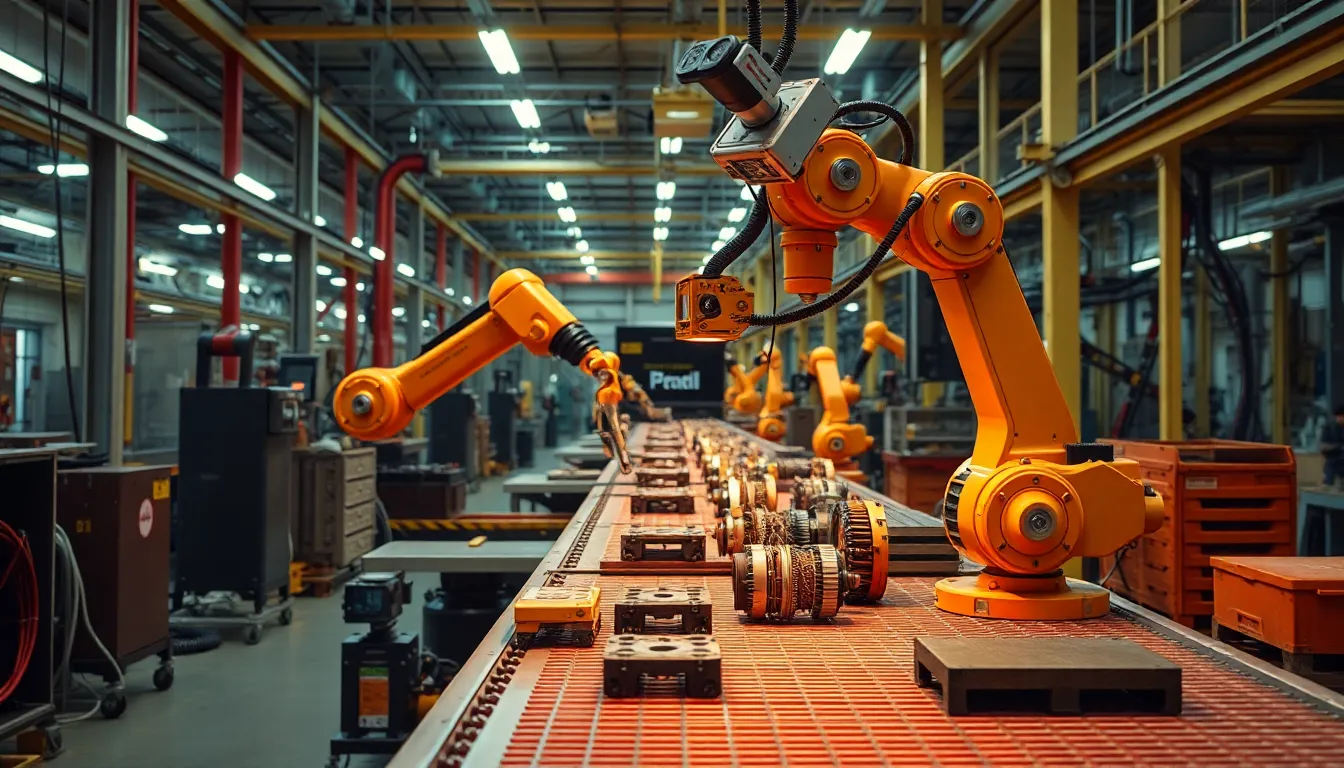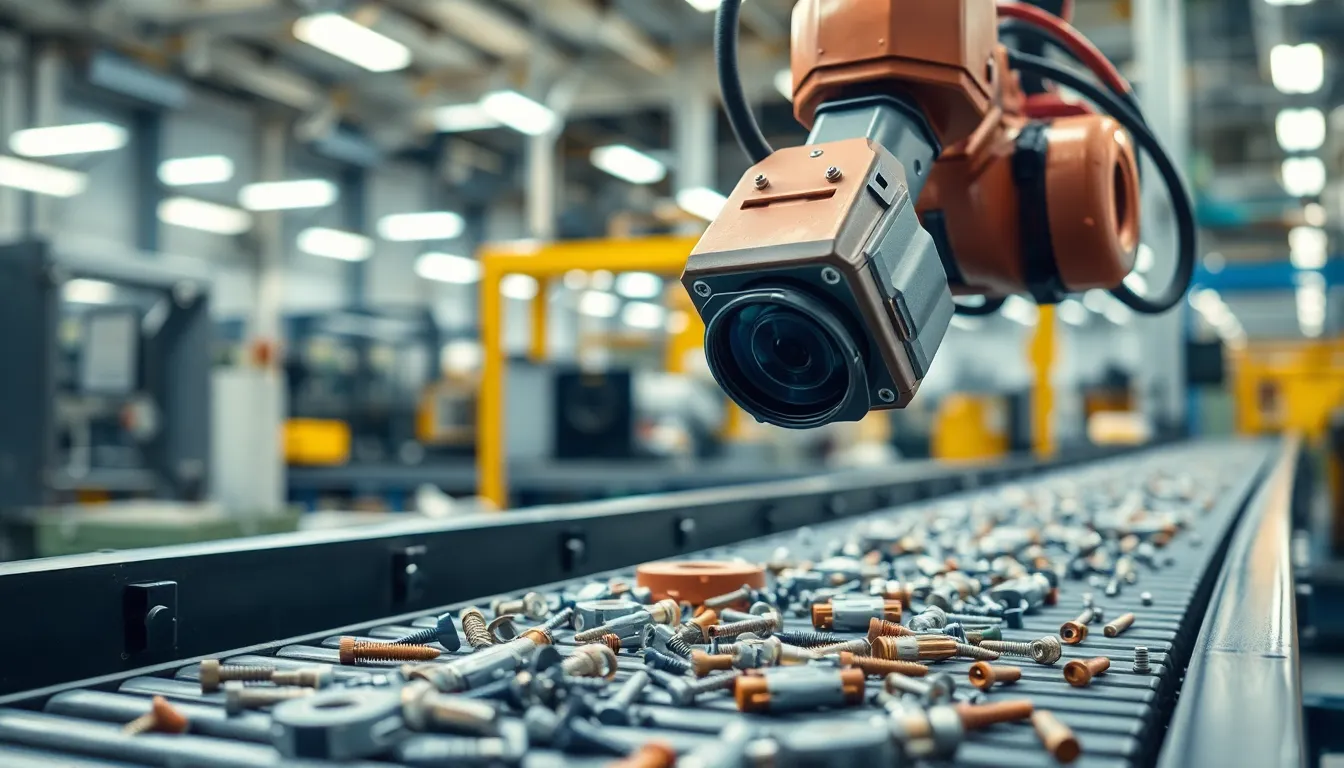In a world where machines are getting smarter by the minute, machine vision is the unsung hero making it all happen. Imagine a robot that can spot a misplaced screw faster than you can say “quality control.” That’s the magic of machine vision—turning ordinary cameras into extraordinary eyes that see, analyze, and interpret the world around them.
Table of Contents
ToggleOverview of Machine Vision
Machine vision plays a critical role in the evolution of automation and intelligence in manufacturing. This technology empowers machines to interpret and process visual data, enabling efficient and accurate operations.
Definition and Importance
Machine vision refers to the use of cameras and computer algorithms to inspect, analyze, and identify objects. Its importance lies in enhancing precision and reducing errors in various applications including quality control and assembly line tasks. By using machine vision, companies achieve higher productivity and lower operational costs, ultimately improving product quality and reliability. The ability to detect defects and ensure proper placement of components transforms traditional manufacturing processes into streamlined operations.
Key Components
Key components of machine vision systems include cameras, lighting, and software. Cameras capture images, which serve as the foundation for visual analysis. Proper lighting is essential for enhancing image quality and reducing shadows that might obscure details. Software processes the captured images, utilizing algorithms to interpret the data and make decisions based on predefined criteria. Additionally, integration with other systems, such as robotics and data analytics platforms, strengthens the capabilities of machine vision technology, facilitating seamless operation in various industries.
Applications of Machine Vision

Machine vision finds extensive applications across various sectors, playing a critical role in enhancing operational efficiency and accuracy. This technology significantly benefits industrial processes and quality assurance measures.
Industrial Automation
Machine vision systems enhance industrial automation by enabling machines to perform complex visual tasks. They allow robots to locate, inspect, and manipulate objects with high precision. Cameras equipped with advanced algorithms analyze images in real time, providing feedback for immediate action. This capability streamlines operations and reduces the need for human intervention in repetitive tasks. In manufacturing settings, organizations often deploy machine vision to identify parts and ensure proper assembly. Integrating this technology leads to increased productivity and improved safety standards within production lines.
Quality Control
Quality control processes leverage machine vision to maintain high standards in product manufacturing. Systems perform rapid inspections to detect defects and ensure products match specifications. With the ability to analyze millions of images in seconds, machine vision eliminates human errors in visual inspections. Data collected during these inspections contributes to identifying trends and managing quality improvements. Industries utilize machine vision to enhance reliability in final products and decrease the likelihood of recalls. As a result, many companies experience significant cost savings through improved quality assurance practices.
Technologies Behind Machine Vision
Technologies enabling machine vision play a crucial role in enhancing the capabilities of automated systems. These technologies encompass various image processing techniques and the integration of machine learning and artificial intelligence.
Image Processing Techniques
Image processing techniques are foundational to machine vision systems. Techniques like edge detection, histogram analysis, and morphological operations allow systems to extract essential features from images. Filters enhance image quality, helping to reduce noise and improve clarity. The application of segmentation methods facilitates the isolation of objects from backgrounds, aiding in accurate analysis. Optical character recognition converts images of text into machine-encoded text, enabling data extraction from printed materials. Advanced techniques like pattern recognition contribute to identifying and classifying objects based on their shapes and sizes.
Machine Learning and AI Integration
Integration with machine learning and AI significantly boosts machine vision capabilities. Algorithms analyze visual data, allowing systems to learn from examples and improve over time. Supervised learning techniques utilize labeled datasets for training, enabling accurate predictions and classifications. Unsupervised learning techniques identify patterns without labeled data, enhancing the system’s adaptability. Coupled with deep learning, convolutional neural networks enhance feature extraction and object recognition, providing greater precision. Machine vision applications benefit from this integration by becoming more autonomous and efficient in tasks such as quality control and defect detection.
Challenges in Machine Vision
Challenges arise in machine vision, particularly due to environmental factors and data quality. These challenges can impact system performance and precision in various applications.
Environmental Factors
Environmental conditions can significantly affect machine vision performance. Lighting variations, such as shadows and glare, often hinder accurate image capture. Temperature fluctuations might also influence camera functionality and sensor sensitivity. Contaminants like dust or moisture can obscure lenses, leading to degraded image quality. Furthermore, physical obstructions in the environment may disrupt the vision system’s ability to detect objects effectively. Addressing these factors requires careful consideration of the operational environment to ensure consistent and reliable machine vision outcomes.
Data Quality and Processing
Data quality plays a pivotal role in machine vision effectiveness. Low-resolution images can lead to inaccurate analysis and misclassification of objects. Inconsistent image formats or data collection methods further complicate the processing pipeline. Additionally, the sheer volume of data generated during inspections demands efficient processing techniques to avoid bottlenecks. Advanced algorithms must manage and filter data to extract critical features, which directly impacts decision-making accuracy. Therefore, maintaining high data quality remains essential for optimizing machine vision systems and ensuring successful implementation across industries.
Future Trends in Machine Vision
Emerging advancements in machine vision continue to shape the future of various industries. Machine vision technology is evolving rapidly, driven by innovations in image processing and AI integration.
Advancements in Technology
Image processing techniques advance consistently. Recent developments in deep learning models significantly enhance object recognition capabilities. Convolutional neural networks (CNNs) now achieve higher accuracy levels in complex visual analysis tasks. AI algorithms also adapt dynamically, improving performance as they learn from new data inputs. New hardware, including high-resolution cameras and specialized lighting, supports more precise image capture. Continuous improvements in processing speed further enhance real-time analysis abilities. Enhanced connectivity with cloud computing enables more robust data management and analytics, ensuring swift decision-making processes.
Potential Impact on Industries
Machine vision’s impact across industries promises significant transformations. Manufacturing stands to benefit tremendously, optimizing production lines through automated inspections and reducing human error. Additionally, quality control processes become more efficient, allowing businesses to meet strict compliance standards faster. The healthcare sector utilizes machine vision for Diagnostic imaging, improving patient outcomes through faster, more accurate interpretations. Retailers gain insights from visual data, enhancing inventory management and facilitating seamless customer experiences. Exposure to machine vision technology empowers industries to achieve higher productivity and cost reductions, promoting overall business growth.
Machine vision stands at the forefront of technological advancement. Its ability to enhance automation and improve quality control processes makes it indispensable across various industries. As machine vision systems evolve through innovations in image processing and AI, they’re set to redefine operational efficiency and accuracy.
The integration of advanced algorithms and machine learning not only boosts performance but also addresses challenges related to environmental factors and data quality. With its growing applications in sectors like manufacturing, healthcare, and retail, machine vision is poised to drive significant productivity gains.
By embracing this technology, businesses can achieve cost reductions and foster growth, positioning themselves for success in an increasingly competitive landscape.



